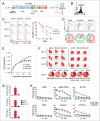Fine-tuning the CAR spacer improves T-cell potency
- PMID: 28180032
- PMCID: PMC5214260
- DOI: 10.1080/2162402X.2016.1253656
Fine-tuning the CAR spacer improves T-cell potency
Abstract
The adoptive transfer of genetically engineered T cells expressing chimeric antigen receptors (CARs) has emerged as a transformative cancer therapy with curative potential, precipitating a wave of preclinical and clinical studies in academic centers and the private sector. Indeed, significant effort has been devoted to improving clinical benefit by incorporating accessory genes/CAR endodomains designed to enhance cellular migration, promote in vivo expansion/persistence or enhance safety by genetic programming to enable the recognition of a tumor signature. However, our efforts centered on exploring whether CAR T-cell potency could be enhanced by modifying pre-existing CAR components. We now demonstrate how molecular refinements to the CAR spacer can impact multiple biological processes including tonic signaling, cell aging, tumor localization, and antigen recognition, culminating in superior in vivo antitumor activity.
Keywords: CAR T cell; T cells.
Figures







References
-
- Jensen MC, Riddell SR. Design and implementation of adoptive therapy with chimeric antigen receptor-modified T cells. Immunol Rev 2014; 257(1):127-44; PMID:24329794; http://dx.doi.org/10.1111/imr.12139 - DOI - PMC - PubMed
-
- Dotti G, Gottschalk S, Savoldo B, Brenner MK. Design and development of therapies using chimeric antigen receptor-expressing T cells. Immunol Rev 2014; 257(1):107-26; PMID:24329793; http://dx.doi.org/10.1111/imr.12131 - DOI - PMC - PubMed
-
- Maude SL, Frey N, Shaw PA, Aplenc R, Barrett DM, Bunin NJ, Chew A, Gonzalez VE, Zheng Z, Lacey SF et al.. Chimeric antigen receptor T cells for sustained remissions in leukemia. N Engl J Med 2014; 371(16):1507-17; PMID:25317870; http://dx.doi.org/2184948610.1056/NEJMoa1407222 - DOI - PMC - PubMed
-
- Brentjens RJ, Riviere I, Park JH, Davila ML, Wang X, Stefanski J, Taylor C, Yeh R, Bartido S, Borquez-Ojeda O et al.. Safety and persistence of adoptively transferred autologous CD19-targeted T cells in patients with relapsed or chemotherapy refractory B-cell leukemias. Blood 2011; 118(18):4817-28; PMID:21849486; http://dx.doi.org/10.1182/blood-2011-04-348540 - DOI - PMC - PubMed
-
- Eshhar Z. The T-body approach: redirecting T cells with antibody specificity. Handb Exp Pharmacol 2008(181):329-42; PMID:18071952; http://dx.doi.org/859360410.1007/978-3-540-73259-4_14 - DOI - PubMed
Publication types
Grants and funding
LinkOut - more resources
Full Text Sources
Other Literature Sources
